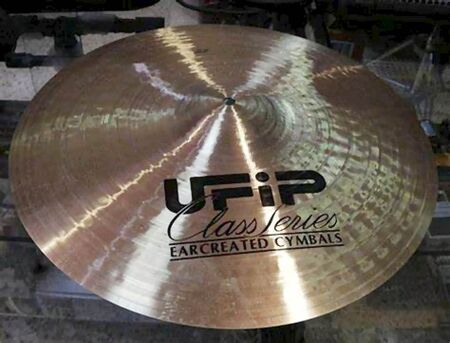UFIP History
In the early 20th century the "Agati-Tronci" company, a known pipe organ manufacturer, began the production of cymbals, as they were difficult to import from Turkey.In the early 20th century the "Agati-Tronci" company, a known pipe organ manufacturer, began the production of cymbals, as they were difficult to import from Turkey.
In 1926 a worker for the Tronci family, Fiorello Zanchi, left the company to start a new cymbal manufacturer with Manlio Biasei, the "Zanchi & Biasei" company. A number of cymbals manufacturers were founded in Pistoia after the First World War, starting a competition.
A number of cymbals manufacturers were founded in Pistoia after the First World War, starting a competition.
On January 6, 1931 four companies (Marradi-Benti, Zanchi & Biasei, Rosati Leopoldo and A. & B. Fratelli Tronci) founded a cooperative society called UFIP to stop the competition between cymbals manufacturers.
In 1947 Zanchi left UFIP to start his own company, Zanchi (later spelled "Zanki"). In 1968 UFIP changed from a cooperative society to an actual production company.
From Paolo Sburlati, Paiste distributor in Italy:
"There were several families in Pistoia, all bronze casters.
The Tronci family produced the big bronze gates at the entrance in Pistoia two centuries ago and they are still there today.
The boss of the families decided to get together and create a big cymbal factory called Unione Fabbricanti Italiani Piatti. All well at the beginning, but typical of hot blooded Tuscan people, they disagreed after short time and each boss went his own way, all creating new cymbal factories: Biasei with Spadaccini created Tosco, Roberto gave birth to Zanki and Luigi kept the name and the Ufip factory. They also started fighting each other on the market and this benefited the competition at the beginning."
Why is UFIP important and why are they different?
UFIP is the second oldest cymbal company (est. 1931) to produce cymbals from B20 bronze.
They are unique because they come from the Italian culture of church bell making or “bronze casters” as they call themselves. They use traditional techniques that have been practiced for several hundred if not a thousand years on casting bronze church bells.
Originally, their cymbals were gravity cast, at some point we believe possibly in the mid-1970s, UFIP developed the “rotocasting” technique where molten bronze is poured into a spinning mold that is made in the shape of a cymbal: this includes the bell and the “bow” or curve of the cymbal.
This process produces a dense and consistent alloy without inclusions, porosity or defects. This process also creates a different sounding cymbal because it is not hot rolled or cold rolled at any point but it is hammered and lathed (most models).
For several decades, UFIP was the only other cymbal company (besides Paiste) to make their own gongs.
What is centrifugal casting and why is it better?
The process involves using a centrifugal force (high-speed rotation action) to exert pressure on the molten metal, and it is poured from an external source into a spinning die. The centrifugal force acts to distribute the molten metal in the spinning die at pressures close to 100 times the force of gravity. The mold rotates until the whole casting solidifies. Because of the high G-forces involved in this casting method, the less dense materials, including impurities, are forced to go to the inside diameter periphery of the part, which is subsequently removed by machining, and defects related to gas and porosity are reduced.









